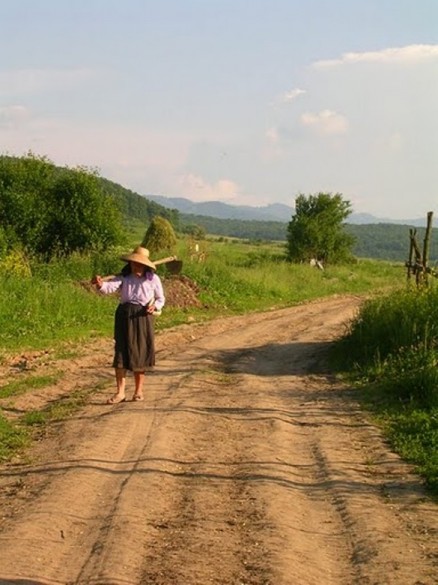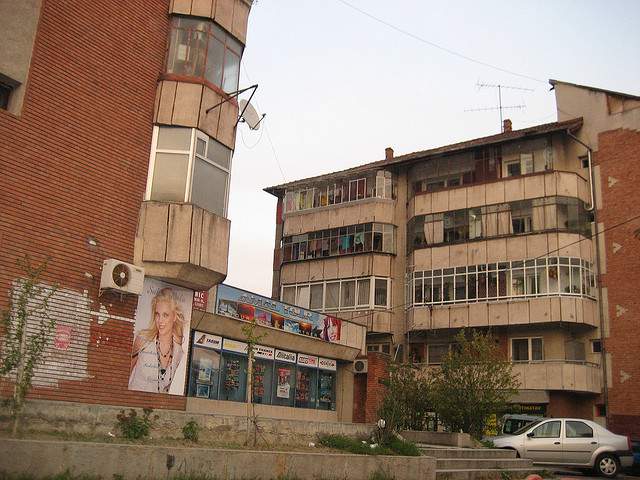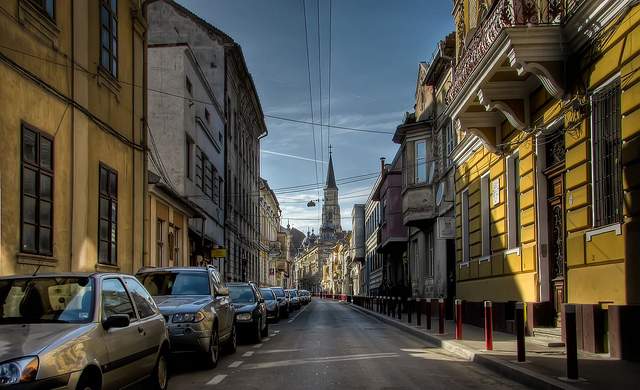Sitting at the crossroads of old trade routes that linked Western Europe with the Far East, locked inside a ring of Slavic countries (except for Hungary), Romania confuses at first with its … latinity. The mix of Orient and Occident is specific to this country and it sets Romania apart from her Eastern European colleagues. You’ll find it in the food, culture, architecture, and nonetheless in the behavior of the people.
Romania has a complex history and gorgeous nature, and the people just add value to all the hidden pleasures this Eastern European country has to offer. Ask Prince Charles of England, he has a number of properties in Transylvania which he first visited in 1998. It even seems that he can trace his roots back to Vlad the Impaler. Though part the EU, Romania still maintains its own currency, a very good thing for tourists, because prices are not fully aligned with Western European ones.
Castles and Fortresses – Go medieval

Bran Castle, wrongly labeled as Dracula’s castle, is a scenic, movie-set like citadel overseeing a green valley from the height of a cliff. Only 20 minutes away is the Râşnov Medieval Fortress built in the 13th century to ward against Tatar invasions. This fortress also stands high up on a steep hill with a remarkable panoramic view of the countryside. An hour away is Sighisoara, the birthplace of Vlad the Impaler, with its small but charming Old Town dating back to the 12th century, a UNESCO World Heritage Site. The Old Town sits on a hill, surrounded by defense walls that still carry the dents of cannonballs from past battles.
Vlad the Impaler was born here and spent about 5 years of his life. His house is still standing and welcomes you to visit it. Also linked to Vlad Dracul is the Poenari Citadel to the South, high in Fãgãraş Mountains, overseeing the Argeş River canyon from a spectacular cliff. Poenari has the reputation to be one of the most haunted places in the world, a place that Vlad the Impaler loved and made it his favorite spots (mostly due to its strategic position). Getting to the citadel is challenging, as you need to go up 1480 steps.
If you like not-so-touristy (albeit spooky) places this is the place to go, as it does not receive many visitors and most of the tourists are Romanians. Legend says that the Discovery Channel team ran out from the castle screaming with terror while filming a documentary on the world’s most haunted places. The Corvinesti Castle in Hunedoara County is one of the most important gothic castles in Transylvania. Vlad the Impaler was imprisoned here for a while, as Mathias Corvinus, the Transylvania prince at the time and owner of the castle, did not like Vlad at all and wanted him dead.
Monasteries – Unlock your spirituality

The Northeast, Molodva and Bucovina, is splattered with Eastern Orthodox monasteries specific to Romania. Voroneţ, Moldoviţa, Suceviţa, an Humor are more than 500 years old, have fortified walls behind which you find an oasis of medieval history and Orthodox spirituality.
These are all UNESCO World Heritage Sites. Voroneţ is the best preserved and it is sometimes known as the Sixtine Chapel of the East. Do not expect Michelangell-esque grandeur, the monastery is quite small, but rich in Byzantine art and history. Voroneţ was built by Ştefan cel Mare (Stephen the Great, cousin of Vlad the Impaler) in gratitude to God for winning in 1475 the battle against Suleiman Pascha, leader of the Ottoman Empire army. The predominant color of Voroneţ is blue, a unique color known as the “Voroneţ blue” because nobody has been able to reproduce it, its secret formula vanished along with the anonymous artist. Monks or nuns live in small cells built around the walls of the monasteries. They care for the monasteries and live a simple life, in constant prayer. They can be good guides to the history of the place, and can introduce you to Orthodox art and belief. The colorful frescoes on the monastery walls in Byzantine style, the serenity of the place, and the ambiance of Eastern spirituality envelop the monasteries in an exotic aura for the non-Orthodox and give a feeling of home for the Eastern Orthodox.
Communist legacy – Experience communism at home
Romania was under communist dictatorship for almost half a century, with a profound effect on the people and the country. Under Ceausescu, Romania developed its own brand of communism, more virulent and radical than in the neighboring countries. There are a lot of vestiges from the Golden Era (how Ceausescu’s reign was sarcastically called) that can give you a better idea of life under communism. You can pass through one of the worker towns with horrible communist architecture like Petrila or Hunedoara.
Both towns are at least 500 years old, so there is a lot of earlier history to the region as well. Petrila is a mining town where Ceausescu forcefully moved peasants from Moldova. In the Hunedoara you can contrast Romania’s glorious past architecture as seen in the Corvineşti Medieval Castle with the crammed, dilapidated apartment buildings grouped in grey depressing communist projects. Peasants whose lands were taken by the state cooperatives were forced to move and live in these ghettos and switch from farming to factory jobs.
To see the extent of the grandeur that obsessed communist dictators, you must visit Casa Poporului (People’s House) in Bucharest. It is a neoclassical architectural monster built by Ceauşescu and it is the second largest building in the world after the Pentagon with a surface of 3,552,090 square feet. It has 1,000 rooms and 12 floors, 480 chandeliers amounting 3,500 tons of crystal, 2,200,000 square feet of woolen carpets, curtains embroidered in gold and silver, and carries 1 million cubic meters of marble. The biggest room, the Union Hall, has a 3 ton chandelier and a surface of 23,680 square feet. To make space for this monster building, a public display of Ceausescu’s megalomania, about 30,000 neo-classical private houses and 50 churches were demolished. For more in depth trip into Romania’s communist past, visit Sighetul Marmatiei, a city in the beautiful and culture rich Maramures region. The communist prison in town was transformed into a Memorial for the victims of communism.
Nature – Unleash the adventurer inside
Romania has green rolling hills, vast planes, rapid rivers, caves, cliffs, volcanoes. In the summer months while hiking in the mountains, you can meet the last free roaming shepherds of Europe, along with bears, wolves, deer, or wild boars. There is the Retezat Natural Reserve, Moldoveanu Peak (highest point in Romania), the mud volcanoes, hundreds of caves, waterfalls are all for you to explore. Whether you are a beach bum or an avid hiker, if you like skiing or spelunking, Romania’s rich and diverse nature offers it all.
The nature in Romania is not only beautiful, but it is full of ancient mysteries. Ceahlau Mountain, of rare beauty, chills with the strange lights hovering above its peaks. It is believed to be the home of the ancient Dacians supreme god Zamolxis. There are many legends and mysteries that surround this mountain, the second sacred mountain of Eastern Orthodoxy after Athos in Greece. Two amazing optical phenomena take place here: in the beginning of August, at sunrise, the peaks Toaca and Shepherd’s Stone cast a shadow of a perfect pyramid, visible for a couple of hours. In the same period, above the Toaca peak a pillar of light shoots up in the sky, for a much shorter period of time. The locals call it the Path to Heaven. Some say this is happening because through Toaca Peak passes one of the energy lines of the Earth.
Wide sandy beaches stretch for kilometers along the Black Sea. You can stay in resorts with names that cover the whole Solar System: Neptun, Saturn, Venus, or Jupiter. If you want something more rural and bohemian, Vama Veche and 2 Mai are the best choice. They are small fishing villages close to the border with Bulgaria. Here you can stay with a local family of pitch your tent on the beach, eat in thatched roofed bars on the beach, and party around a bonfire on the beach all night long. There are nude beaches in the area, not a big deal as regular beach etiquette in Romania encourages topless swimsuits for ladies. Guys, you’re in for some nice views on the Romanian seaside. Unfortunately, Vama Veche and 2 Mai have been pestered lately by some show-offs with jet skis, which disrupt the quiet breeze and splash of waves.
The Danube enters the Black Sea on Romanian territory forming the Danube Delta, a UNESCO Heritage Site as well, a unique ecosystem in Europe. Highly diverse in flora and fauna, it is one of the richest ecosystems in Europe, with 320 species of birds during summer, a paradise for migratory birds that come here to nest from Mongolia, the Arctic, and Siberia. Floating reed islands (plaur) make a surreal view for the traveler. The Letea Forest has 700 year old oak trees, sand dunes and wild horses.
If you rent a car and travel around Romania, the Transfagarasan will offer sensational views: it is the road that crosses the Carpathian Mountains from North to South, offering 45 miles of dramatic scenery and hairpin curves that climbs up to 2000m. It is usually closed from late October till June due to heavy snow. While crossing the Transfagarasan, stop at glaciar Lake Balea and Poenari Citadel.
Villages – Go rural

Romanian countryside has a unique, rustic, calm charm, and every season is charming. Many villages are still a window back in time, and they are the perfect place to disconnect from the tumult of the modern world. Horse-drawn carriages, wooden ploughs, people wearing traditional clothes, unpaved roads and incredible starry skies are all for you to enjoy. In the afternoon elderly people step out of their homes and sit on the benches in front of their houses to catch up on the latest village news and watch people go by. There are 7 Transylvanian villages on the UNESCO World Heritage list: Biertan, Câlnic, Dârju, Prejmer, Saschiz, Valea Viilor and Viscri. All have tong-twister names and medieval fortified churches. Biertan is the best known of all. Remote, with one of the finest fortified gothic churches in Romania, it was one of the only three places in Europe that permitted a divorce back in medieval days.
Maramureş, the Northwestern part of Transylvania, preserved its villages and traditions as nowhere else in the country. The people here are proud to say they are the followers of free Dacians, as this area was never conquered by Romans. Maramureş is renowned for the carved wooden doors and for its wooden Churches (also UNESCO World Heritage). An out of the ordinary attraction is the Merry Cemetery of Săpânţa, where death is taken with a grain of humor. The blue crosses carry naïve paintings representing the “tenants”, along with a few funny verses about their life. There are many guest houses in Maramureş, traditional, rustic and comfortable, and many of them offer cultural programs that introduce the visitor into the daily village life and customs.
Cities – Western style with an oriental-communist twist
Romanian cities have a distinguished architecture, a Western European and communist combo, with a touch of Romanian architectural style especially in the southern cities. Every city has a downtown, which is easily accessible by foot or public transportation. There is a vibrant nightlife, with clubs and bars that offer a wide range of variety, from student places where the atmosphere is relaxed and drinks and finger-food are under 3$, to exclusive VIP clubs frequented by the “elite” featured in scandal magazines, and everything in-between.
I really recommend the cafes and bars where often there is live music, funky décor (where tables are actually doors, and chairs are made of pressed cardboard), from art bars with modern local artist works on display, or dungeons in ex-wine cellars that give the place a mysterious and retro atmosphere. Prices are great, cocktails are 4-5$, beer and house wine goes for a few bucks. Cafes offer lavazza or Illy Italian coffee, capucinos for $3 and 1$ expressos. Terraces are perfect hangout for warm sunny days, you can relax, read your travel guide and watch people pass by. Local beers are the best, go for Ursus, Ciuc or Timisoreana. Blonde or dark, you will be satisfied. Shopping malls popped in recent years and they also are a hangout place, pizza hut is quite elegant, and cafes dot the hallways, with modern stylish furniture. One warning though – smoking is allowed so after a night out you will surely stink of cigarette smoke. Mall cafes and outside terraces are best to ward off cigarette smoke.
Take public transportation, it is cheap, fares are 50c and busses come often. Getting oriented is slightly more difficult, so you need to have good directions. You can usually ask people, young ones speak very good English. If you are not adventurous take a cab, make sure you ask the fare in advance or that you have the name of a few reliable taxi companies, fares are small, 3-4$ can get you crosstown.
From Roman ruins to medieval castles and 19 century elegant European architecture, you can find everything in-between in most of the big cities and surrounding: Cluj, Brasov, Iasi, Timisoara, Constanta, or Sibiu, the cultural capital of the European Union in 2008.
Luminita Cuna writes at https://whereitravel.wordpress.com/
Photos by: 2, 3, 4, 6 – others by the author and may not be used without permission


